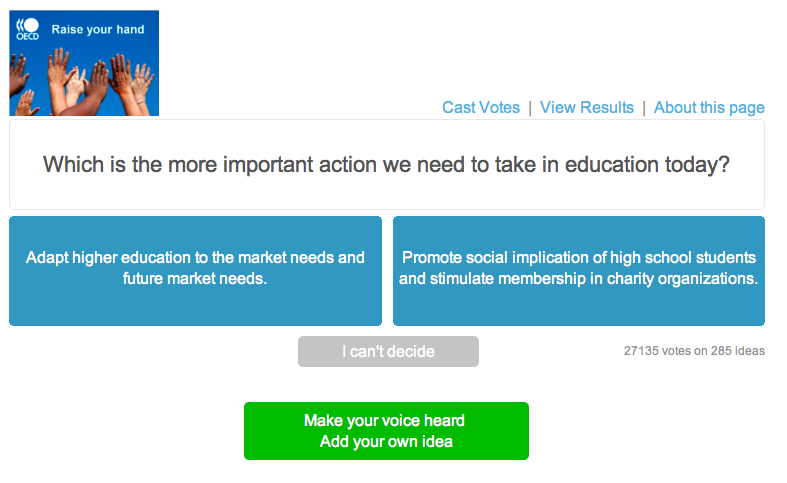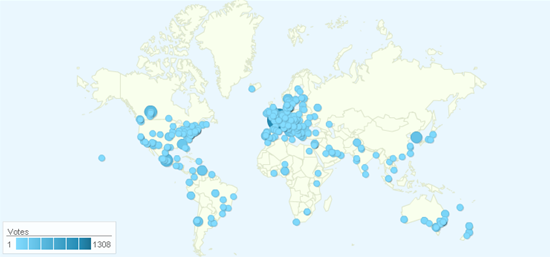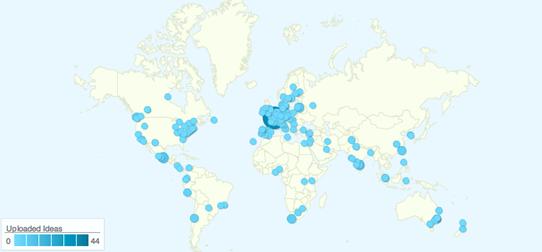Policy-makers often strive to solicit ideas from the public, but making this process effective is very, very hard. Americans need only think back to the health-reform town hall meetings last summer, many of which devolved into chaos. Online approaches, such as President Obama’s virtual town hall meeting, have also ran into problems. So, how can policy-makers discover the best ideas from the public?
The Organization for Economic Cooperation and Development (OECD)–an intergovernmental think tank–recently faced this challenge. They were planning a global summit for education leaders that is taking place in Paris today (November 4th), and they wanted to bring fresh thinking from the public to this group. To achieve this goal, the OECD created an “idea marketplace” at www.allourideas.org, a website that I have been developing with a team of students and web-developers. An idea marketplace allows groups to collect and prioritize ideas in a way that is democratic, transparent, and open. It’s certainly a lot easier than inviting everyone to Paris for the meeting.
Here’s how it worked for the OECD, more specifically Joanne Caddy, Julie Harris, and Cassandra Davis. They “seeded” the website with about 50 ideas (e.g., “Give teachers regular sabbaticals so that they can be trained outside of regular school time or during holidays.”). Then visitors to their idea marketplace were presented with the question “Which is the more important action we need to take in education today?” and two ideas from the pool. The visitors voted for one of the ideas, and then another pair of ideas was presented. This process of pairwise voting continued for as the long as the visitor wished. Also, at any time the visitor could upload an idea which would then go into the pool of ideas to be voted on by others. In this way the idea marketplace allowed the OECD to collect ideas from the community and have the community prioritize them. Both of these steps–collection and prioritization–are needed for a successful “crowdsourcing” of ideas. Here is what the voting looked like to the visitor:

So, how did it work in practice? In just one month, people from more than 90 countries collectively cast more than 27,000 votes.

Equally impressive, these participants uploaded 325 new ideas, again from all over the world.

By combining the voting process with the open uploading of new ideas, this community of stakeholders was able to generate a ranked list that more truly reflected the opinions of the group. The top five ideas (shown below) will be presented to the education leaders today at the summit in Paris, and critically four of these five ideas were uploaded by visitors. In other words, these were ideas that the OECD did not include on their initial list. This example nicely shows how idea marketplaces enable new ideas to bubble-up, allowing groups to learn about things they didn’t even know to ask about.
The top five ideas were:
- Teach to think, not to regurgitate.
- Commit to education as a public good and a public responsibility.
- Focus more on creating a long-term love of learning and the ability to think critically than teaching to standardised tests.
- Ensure all children have the opportunity to discover their natural abilities and develop them.
- Ensure that children from disadvantaged background and migrant families have the same opportunity to quality education as others.
In addition to the OECD, more than 600 idea marketplaces have been created for free at allourideas.org. These have collected about 250,000 votes and 5,000 uploaded ideas. Other policy-related uses have come from student governments (for example, at Princeton and Columbia) and the New York City Government, which is currently using allourideas.org for two projects:
- The Department of Parks and Recreation is using allourideas.org to prioritize residents’ ideas for the new master plan for the parks in Northern Manhattan.
- The New York City Mayor’s Office of Long-Term Planning and Sustainability is using allourideas.org to integrate residents’ ideas into PlaNYC 2030, New York’s citywide sustainability initiative.
allourideas.org is an open-source research project that has received generous funding from CITP and Google. You can keep up on the project by reading our blog or following us on Twitter or Facebook.
